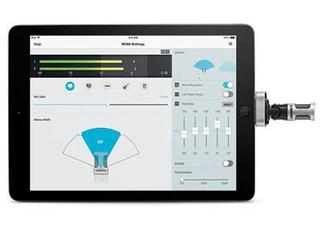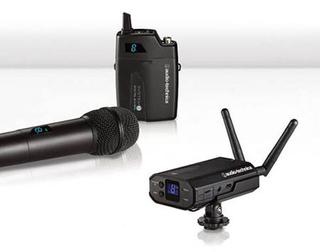Changing Mic Market Still Demands Quality
NEW YORK—Multichannel delivery to the home continues to expand, increasing the need for microphones that have at least two-channel capabilities. Bloggers and v-loggers require high-quality, affordable mics, and the trend to ever smaller lavaliere microphones continues unabated. Throw in the fact that broadcasters—including the large networks—are using smart devices for ENG and you’ve got a changing mic market.
BLURRING THE LINES
Sennheiser showcased an entirely new microphone system for videographers at the NAB Show. The company’s interest in this segment of the market is an indicator that videography is becoming a serious target for high-end microphone manufacturers.
Sennheiser also gave demos of the Esfera, the surround mic that was released last year. Adding intelligent design to just a pair of microphones yields audio that fully conveys the surround sound experience, according to the company.

ShurePlus MOTIV Mobile Recording App Audio-Technica officials agree that the demand for high-quality audio microphones is escalating. “There’s a great need for microphones that can supply high-quality audio for surround mixes, from the foundational, ambient sounds to the more prominent audio tracks,” said Gary Boss, marketing director, professional products for the company.
A-T showed several shotgun mics that offer both mid-side and stereo operation, along with an array of M-S and X/Y stereo mics. New A-T products on display include the AT2020USBi cardioid condenser microphone and the BP40 dynamic broadcast vocal microphone. Aimed at the home studio, podcast, and field recording market, the AT2020USBi is evidence that the line that once firmly separated the pro and amateur broadcast areas continues to blur.
Sony believes that it’s critical to capture ambient sound in stereo, with the company’s flagship ECM-680S stereo shotgun microphone and more affordable ECM-MS2 offering this capability. Distinctions between the two models include the slightly longer reach that the ECM-680S offers, a slight difference in frequency response, and connectivity.
The ECM-MS2 sports a pair of three-pin XLR connectors while its big brother terminates in a five-pin XLR that can easily be broken out into two three connector XLRs. Both microphones can operate in mono mode as well. The ECM-680S provides a switch that the operator uses to move between stereo and mono, while the ECM-MS2 requires the operator to physically disconnect one of the channels.
GETTING SMALLER
The trend towards smaller, less intrusive microphones shows no sign of letting up. To that end, Shure introduced the MVL Omnidirectional Condenser Lavalier Microphone, which connects directly to any iOS and Android device and is designed for those looking to capture quality audio for field recording, dictation, news reporting, and audio video recording.
Connecting directly to tablets and smartphones, the MVL is designed to be used in conjunction with Shure’s ShurePlus MOTIV Mobile Recording App, the company’s latest iOS app which is loaded with smart features for high-quality digital recording on-the-go and allows users to share audio files via email, text and SMS. With a user-friendly tie-clip, the MVL lavalier can be positioned directly near the mouth for increased audio clarity.

Audio-Technica’s new System 10 2.4 GHz digital wireless platform DPA agrees that the migration to smaller microphones is a continuing phenomenon. “The broadcast market is evolving and we have seen an increased demand for smaller microphones, wireless microphones and microphones you can use in acoustically demanding environments,” said Mikkel Nymand, product manager and tonmeister for the Danish audio company.
Visitors to DPA’s NAB booth saw two new microphones designed specifically to improve and meet the needs of the changing broadcast landscape, including the d:fine In-Ear Broadcast Headset Microphone, which Nymand describes as “a combination of our reference headset and an in-ear driver solution.
“It was built with broadcast hosts and guests in mind who use in-ear monitors to communicate with producers backstage or to hear feedback from those outside the studio,” he said.
DPA’s new d:facto Interview Microphone, the latest in the company’s d:facto range, was also on display. “The d:facto Interview mic is a high-end handheld reporter’s mic, with superior voice clarity, linearity and wind rejection, and it offers the ability to switch the capsule to fit the needs of the user,” Nymand said.
Sony’s newest laveliere, the ECM-88B, has a capsule design that the company says achieves a wide frequency response—particularly on the low end— an extremely low noise floor, and a nearly complete elimination of the cable noise that results when a lav microphone’s cable is secured under talent clothing. “This is done through a dual rectangular diaphragm design,” said Sony’s Pro Audio Product Manager Andy Munitz. “They’re wired out of phase with one another and the physical cable noise gets cancelled out at the capsule.”
QUALITY STILL COUNTS
Price point is a touchy topic but are manufacturers of high-quality microphones feeling pinched in this area? Not necessarily.
“Despite the fact that there are new players in the market using price as the main selling proposition, we have seen that users still know that premium performance comes at a price,” said Achim Gleissner, head of commercial management broadcast and media for Sennheiser. “The huge success of our Digital 9000 wireless system is just one example.”
DPA’s Mikkel Nymand concurs. “Though it’s true that over the last few decades the price points have become lower with more affordable mic options, professionals have an overall acceptance and appreciation that better quality microphones are a bit higher priced—not over-priced, just a bit higher.”
Audio-Technica has a similar perspective. “We can’t stress enough the challenges faced in the wireless microphone market,” Boss said. “With the overcrowding and regulatory uncertainty surrounding TV-band wireless, we need reliable solutions for expanding and working with existing TV-band systems, while introducing new systems that work outside the TV bands.”
For proof, Boss pointed to the company’s 2.4 GHz System 10 digital wireless platform, of which the latest models were shown at the company’s NAB booth. “The big difference we’re seeing is that the race to the bottom seems to have subsided,” he said. “People are once again willing to pay more to get quality audio products, instead of simply seeking out the lowest priced item. They appreciate that quality products cost a bit more and are worth it.”
Get the TV Tech Newsletter
The professional video industry's #1 source for news, trends and product and tech information. Sign up below.













